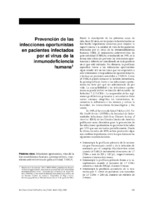Prevención de las infecciones oportunistas en pacientes infectados por el virus de la inmunodeficiencia humana
| dc.date.accessioned | 2015 | |
| dc.date.available | 2015 | |
| dc.date.issued | 2001 | es_ES |
| dc.identifier.citation | (2001) Prevención de las infecciones oportunistas en pacientes infectados por el virus de la inmunodeficiencia humana. Rev Panam Salud Publica;10(2) 125-138,ago. 2001. Retrieved from http://www.scielosp.org/scielo.php?script=sci_arttext&pid=S1020-49892001000800013&lng=en&nrm=iso&tlng=es | es_ES |
| dc.identifier.uri | http://www.scielosp.org/scielo.php?script=sci_arttext&pid=S1020-49892001000800013&lng=en&nrm=iso&tlng=es | es_ES |
| dc.identifier.uri | https://iris.paho.org/handle/10665.2/8600 | |
| dc.relation.ispartofseries | Rev Panam Salud Publica;10(2),ago. 2001 | es_ES |
| dc.subject | Infecções Oportunistas Relacionadas com a AIDS | pt_BR |
| dc.subject | Síndrome de Imunodeficiência Adquirida | es_ES |
| dc.subject | Quimioprevenção | pt_BR |
| dc.title | Prevención de las infecciones oportunistas en pacientes infectados por el virus de la inmunodeficiencia humana | es_ES |
| dc.title.alternative | Preventing opportunistic infections in persons infected with human immunodeficiency virus | en_US |
| dc.type | Journal articles | en_US |
| dc.rights.holder | Pan American Health Organization | en_US |
| dc.description.notes | SyHighly active antiretroviral therapy (HAART), which has been provided since 1995 to patientes infected with human immunodeficiency virus (HIV), has prodeced noticeable results in regard to preventing opportunistic infections in this population. Nevertheless, it is still useful to administer specific prophylactic treatment against opportunistic infections in patients treated with HAART or who cannot or do not wish to take that treatment. prophylactic treatment can be halted when, due to HAART, there is a sustained increase in the CD4+T-lymphosytes count (that count indicates the degree of susceptibility that a person has to opportunistic infections). Guidelines for preventing opportunistic infections were developed in 1995 by the United State Public Health Service and the Infectious Disease Society of America, and they have been reviewed periodically. The last review, done in 1999, marked the introduction of important changes regarding clinical parameters to halt primary and secondary prophylaxis againt Pneumocystis carinii pneumonia,Toxoplasma gondii, and Mycobacterium avium complex. These changes, along with the lated information concerning the transmission of human herpesviruses, immunization of children infected with HIV or exposed to the virus, and certain drug interactions, are the major focus of this review | pt_BR |
Files in this item
This item appears in the following Collection(s)
-
Pan American Journal of Public Health
Revista Panamericana de Salud Pública

